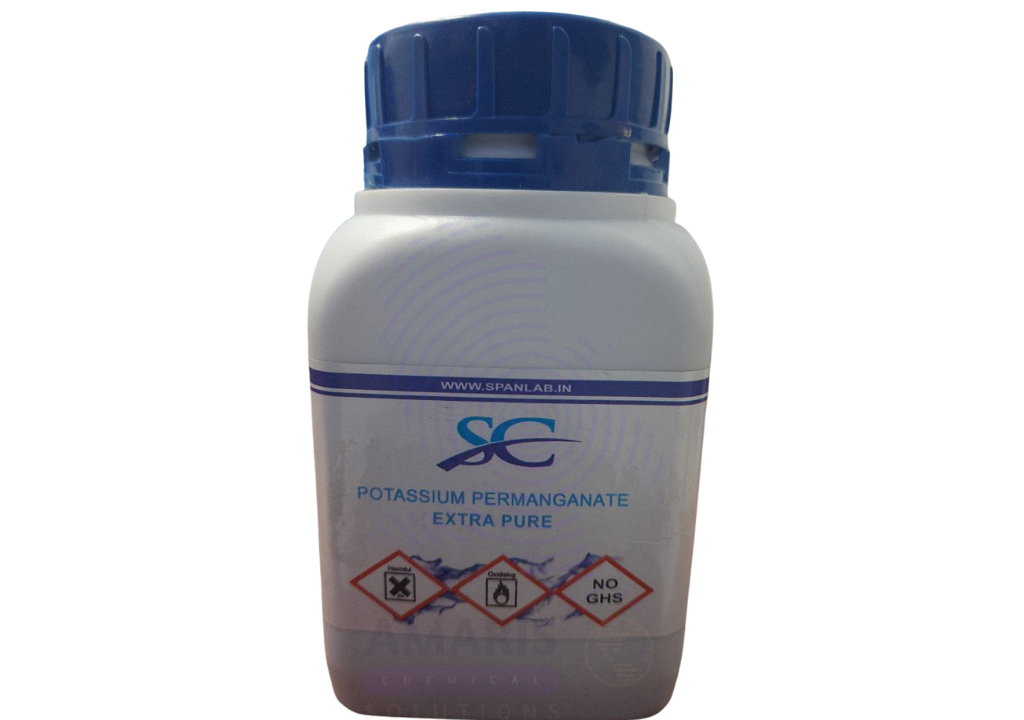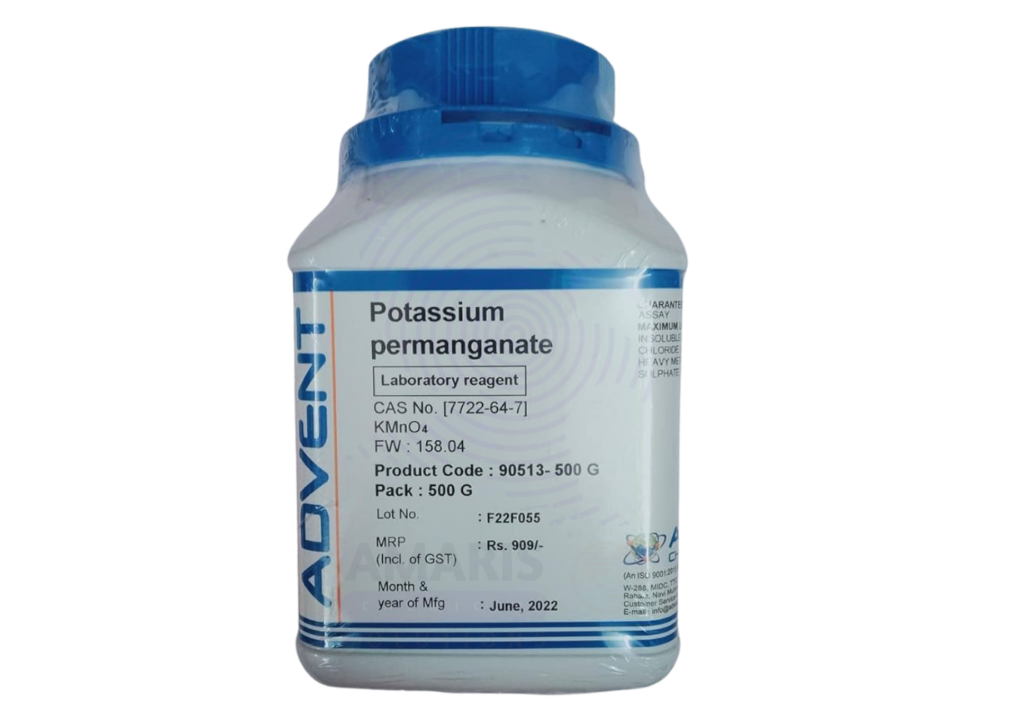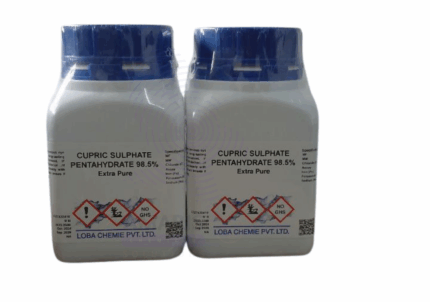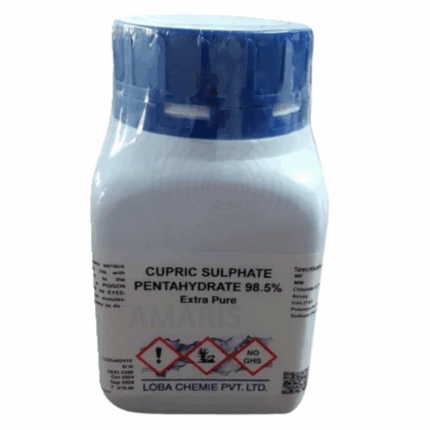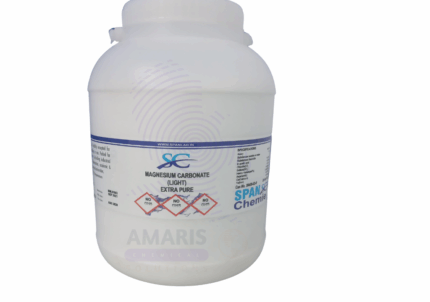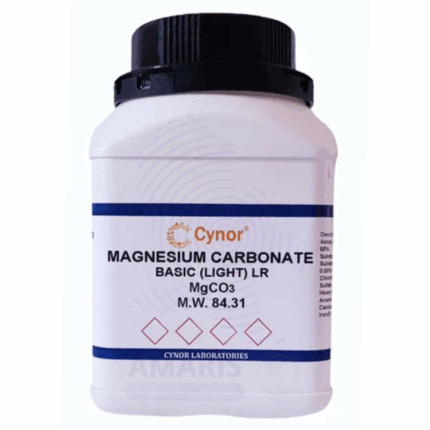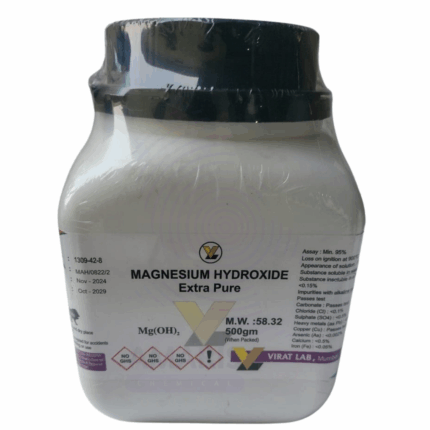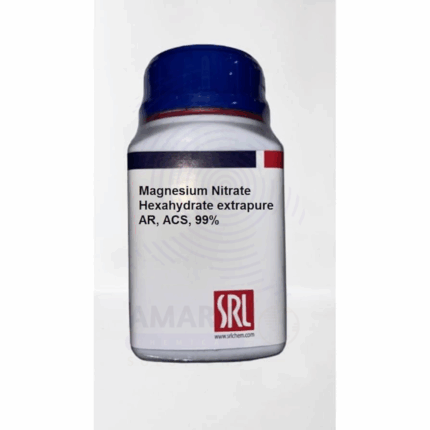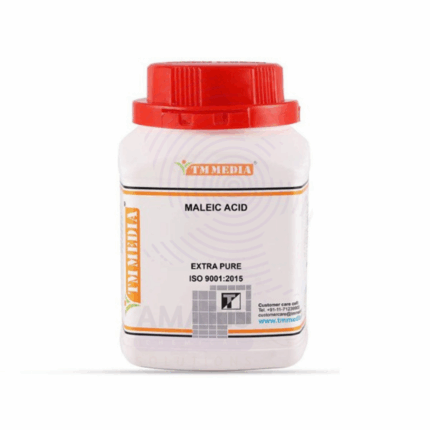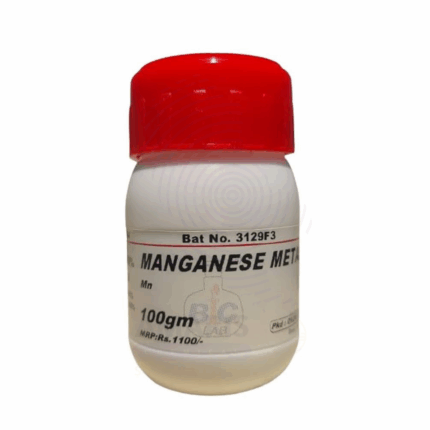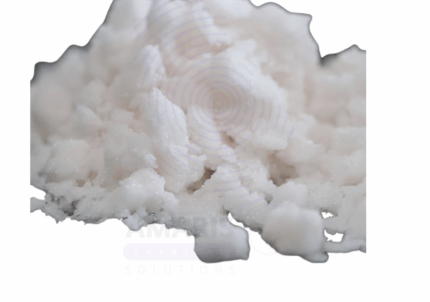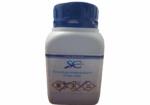
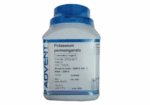
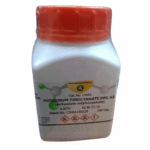
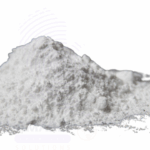
Potassium Permanganate Extra Pure
$ 17.45 Original price was: $ 17.45.$ 17.34Current price is: $ 17.34.
Potassium Permanganate Extra Pure is a powerful oxidizing agent recognized for its deep purple crystals and wide range of applications. In laboratory settings, it is frequently used in redox titrations, organic synthesis, and as a disinfectant due to its strong antiseptic properties. This compound is also valued in water treatment for removing iron, hydrogen sulfide, and organic impurities. Its extra pure grade guarantees high chemical integrity, making it ideal for analytical procedures, research work, and high-precision industrial uses where purity is critical.
Potassium Permanganate Extra Pure
PRIMARY USES
- Oxidizing Agent in Chemical Reactions
- Strong oxidizer used in redox titrations and analytical chemistry.
- Common in qualitative and quantitative analysis of substances like hydrogen peroxide, iron, and oxalates.
- Disinfectant & Water Treatment
- Employed to disinfect drinking water, especially in rural or emergency settings.
- Used in wastewater treatment to oxidize organic impurities and control odor.
- Medical & Dermatological Applications
- Used in dilute solutions for treating skin conditions like eczema, fungal infections, and ulcers.
- Acts as an antiseptic and astringent in clinical hygiene and minor wound care.
SECONDARY USES
- Laboratory Demonstrations
- Ideal for oxidation-reduction experiments, color change reactions, and illustrating reaction kinetics.
- Often used in chemical chameleon demonstrations due to dramatic color transitions.
- Industrial Uses
- Applied in the textile industry for bleaching and dye removal.
- Used in metal surface treatment and cleaning.
- Air and Odor Control
- Incorporated in air filters and deodorizing systems to neutralize gases like hydrogen sulfide and ethylene.
1. Basic Identification Attributes
- Chemical Name: Potassium Permanganate
- CAS Number: 7722-64-7
- HS Code: 2841.61.00
- Molecular Formula: KMnO₄
- Synonyms:
- Condy's crystals
- Permanganate of potash
- Purple salt
2. Physical & Chemical Properties
- Physical State: Solid (crystalline powder or granules)
- Color & Odor: Dark purple or bronze crystals; odorless
- Boiling Point & Melting Point:
- Decomposes before boiling
- Melting Point: ~240 °C (with decomposition)
- Density/Specific Gravity: ~2.7 g/cm³
- Solubility:
- Soluble in water (6.4 g/100 mL at 20°C)
- Slightly soluble in acetone
- pH Level: Slightly alkaline in aqueous solution
- Vapor Pressure & Volatility: Non-volatile
- Flash Point: Not flammable
- Autoignition Temperature: Not applicable
- Viscosity: Not applicable (solid)
3. Safety & Hazard Attributes
- Hazard Class (GHS Classification):
- Oxidizing Solid (Category 2)
- Acute Toxicity (Oral, Category 4)
- Skin Corrosion/Irritation (Category 2)
- Serious Eye Damage (Category 1)
- NFPA Ratings:
- Health: 3
- Flammability: 0
- Reactivity: 1
- Exposure Limits:
- OSHA PEL (as Mn): 5 mg/m³ (ceiling)
- ACGIH TLV (as Mn): 0.02 mg/m³ (respirable); 0.1 mg/m³ (inhalable)
- Reactivity:
- Strong oxidizer; reacts violently with organic materials, acids, reducing agents, and combustible substances
4. Storage & Handling Attributes
- Storage Conditions:
- Store in a cool, dry, and well-ventilated area
- Keep container tightly closed and away from incompatible materials
- Incompatible Materials:
- Glycerol, ethylene glycol, ethanol, reducing agents, strong acids, sulfur
- Container Type:
- HDPE or chemically resistant containers
- Shelf Life & Expiration Date:
- Stable if kept dry and uncontaminated; degrade if exposed to moisture or light
- Special Handling Requirements:
- Use gloves, goggles, and protective clothing
- Use in fume hood to avoid inhalation of dust
5. Regulatory & Compliance Attributes
- Regulatory Status:
- Listed in REACH, TSCA, and controlled by local regulations due to oxidative potential
- Hazard Symbols (GHS Pictograms):
- ⚠️ Warning (Toxic effects)
- 🔥 Oxidizer
- 🧪 Corrosive
- Transportation Restrictions:
- UN Number: 1490
- Hazard Class: 5.1 (Oxidizing substances)
- Packing Group: II
- Waste Disposal Method:
- Neutralize with a reducing agent (e.g., sodium thiosulfate) under controlled conditions
- Dispose according to local environmental regulations (e.g., RCRA in the U.S.)
6. Environmental & Health Impact
- Ecotoxicity:
- Toxic to aquatic life
- Strong oxidant that may affect aquatic systems if released untreated
- Persistence in Environment:
- Decomposes to manganese dioxide in the environment
- Carcinogenicity/Mutagenicity:
- Not classified as carcinogenic by IARC or OSHA
- Biodegradability:
- Not biodegradable; breaks down chemically to manganese compounds
- Not biodegradable; breaks down chemically to manganese compounds
SAFETY PRECAUTIONS
Personal Protective Equipment (PPE):
- Chemical-resistant lab coat
- Nitrile or neoprene gloves
- Safety goggles or face shield
- Dust mask or respirator (if handling large quantities or powder)
Handling:
- Handle in a well-ventilated area
- Avoid inhalation of dust and contact with skin or eyes
- Do not mix with glycerol, alcohols, acids, or organic materials — may cause explosive reactions
- Use non-sparking tools and equipment
- Wash hands thoroughly after handling
Storage:
- Store in tightly sealed containers in a cool, dry, well-ventilated area
- Keep away from heat, flammable substances, and reducing agents
- Do not store near acids or combustible materials
- Clearly label containers and isolate from incompatible chemicals
FIRST AID MEASURES
Inhalation:
- Move victim to fresh air
- Provide oxygen if breathing is difficult
- Seek medical attention if symptoms persist
Skin Contact:
- Immediately flush skin with plenty of water for at least 15 minutes
- Remove contaminated clothing and shoes
- Get medical attention if irritation persists
Eye Contact:
- Rinse eyes cautiously with water for at least 15 minutes
- Keep eyelids open during rinsing
- Seek immediate medical assistance
Ingestion:
- Rinse mouth with water (only if conscious)
- Do not induce vomiting
- Seek emergency medical help immediately
- May cause burns to the mouth, throat, and gastrointestinal tract
FIRE FIGHTING MEASURES
Flammability:
- Not combustible, but a strong oxidizer — may intensify fire
Extinguishing Media:
- Use water spray, dry chemical, or CO₂
- Do not use dry organic materials or foam
Hazardous Combustion Products:
- Releases toxic fumes including potassium oxides and manganese oxides
Firefighter Protection:
- Wear full protective clothing and self-contained breathing apparatus (SCBA)
- Approach fire from upwind
- Cool exposed containers with water spray


 Preservatives(food)
Preservatives(food) Flavor Enhancers
Flavor Enhancers Acidulants
Acidulants Sweeteners
Sweeteners Antioxidants
Antioxidants Colorants(food)
Colorants(food) Nutraceutical Ingredients (food)
Nutraceutical Ingredients (food) Nutrient Supplements
Nutrient Supplements Emulsifiers
Emulsifiers
 Collectors
Collectors Dust Suppressants
Dust Suppressants Explosives and Blasting Agents
Explosives and Blasting Agents Flocculants and Coagulants
Flocculants and Coagulants Frothers
Frothers Leaching Agents
Leaching Agents pH Modifiers
pH Modifiers Precious Metal Extraction Agents
Precious Metal Extraction Agents
 Antioxidants(plastic)
Antioxidants(plastic) Colorants (Pigments, Dyes)
Colorants (Pigments, Dyes) Fillers and Reinforcements
Fillers and Reinforcements Flame Retardants
Flame Retardants Monomers
Monomers Plasticizers
Plasticizers Polymerization Initiators
Polymerization Initiators Stabilizers (UV, Heat)
Stabilizers (UV, Heat)
 Antifoaming Agents
Antifoaming Agents Chelating Agents
Chelating Agents Coagulants and Flocculants
Coagulants and Flocculants Corrosion Inhibitors
Corrosion Inhibitors Disinfectants and Biocides
Disinfectants and Biocides Oxidizing Agents
Oxidizing Agents pH Adjusters
pH Adjusters Scale Inhibitors( water)
Scale Inhibitors( water)
 Antioxidants(cosmetic)
Antioxidants(cosmetic) Emollients
Emollients Fragrances and Essential Oils
Fragrances and Essential Oils Humectants
Humectants Preservatives
Preservatives Surfactants(cosmetic)
Surfactants(cosmetic) Thickeners
Thickeners UV Filters
UV Filters
 Fertilizers
Fertilizers Soil Conditioners
Soil Conditioners Plant Growth Regulators
Plant Growth Regulators Animal Feed Additives
Animal Feed Additives Biostimulants
Biostimulants Pesticides (Herbicides, Insecticides, Fungicides)
Pesticides (Herbicides, Insecticides, Fungicides)
 Active Pharmaceutical Ingredients (APIs)
Active Pharmaceutical Ingredients (APIs) Excipients
Excipients Solvents(pharmaceutical)
Solvents(pharmaceutical) Antibiotics
Antibiotics Antiseptics and Disinfectants
Antiseptics and Disinfectants Vaccine Adjuvants
Vaccine Adjuvants Nutraceutical Ingredients (pharmaceutical)
Nutraceutical Ingredients (pharmaceutical) Analgesics & Antipyretics
Analgesics & Antipyretics
 Analytical Reagents
Analytical Reagents Solvents(lab)
Solvents(lab) Chromatography Chemicals
Chromatography Chemicals Spectroscopy Reagents
Spectroscopy Reagents microbiology-and-cell-culture-reagents
microbiology-and-cell-culture-reagents Molecular Biology Reagents
Molecular Biology Reagents Biochemical Reagents
Biochemical Reagents Inorganic and Organic Standards
Inorganic and Organic Standards Laboratory Safety Chemicals
Laboratory Safety Chemicals Specialty Laboratory Chemicals(Special Laboratory Equipment)
Specialty Laboratory Chemicals(Special Laboratory Equipment)
 Demulsifiers
Demulsifiers Hydraulic Fracturing Fluids
Hydraulic Fracturing Fluids Scale Inhibitors(oil)
Scale Inhibitors(oil) Surfactants(oil)
Surfactants(oil) Drilling Fluids
Drilling Fluids
 Dyes and Pigments
Dyes and Pigments Bleaching Agents
Bleaching Agents Softening Agents
Softening Agents Finishing Agents
Finishing Agents Antistatic Agents
Antistatic Agents
 Admixtures
Admixtures Waterproofing Agents
Waterproofing Agents Sealants and Adhesives
Sealants and Adhesives Curing Compounds
Curing Compounds Concrete Repair Chemicals
Concrete Repair Chemicals Anti-Corrosion Coatings
Anti-Corrosion Coatings
 Surfactants(cleaning)
Surfactants(cleaning) Builders
Builders Enzymes
Enzymes Solvents (Cleaning)
Solvents (Cleaning) Fragrances
Fragrances
 Electronic Chemicals
Electronic Chemicals Catalysts
Catalysts Lubricants
Lubricants Photographic Chemicals
Photographic Chemicals Refrigerants
Refrigerants Automotive chemicals
Automotive chemicals Pyrotechnic Chemicals
Pyrotechnic Chemicals
 Biodegradable Surfactants
Biodegradable Surfactants Bio-based Solvents
Bio-based Solvents Renewable Polymers
Renewable Polymers Carbon Capture Chemicals
Carbon Capture Chemicals Wastewater Treatment Chemicals
Wastewater Treatment Chemicals
 Pigments
Pigments Solvents(paint)
Solvents(paint) Specialty Coatings
Specialty Coatings Binders/Resins
Binders/Resins Additives
Additives Driers
Driers Anti-Corrosion Agents
Anti-Corrosion Agents Functional Coatings
Functional Coatings Application-Specific Coatings
Application-Specific Coatings
 Fresh Herbs
Fresh Herbs Ground Spices
Ground Spices Whole Spices
Whole Spices Spice Blends
Spice Blends Dried Herbs
Dried Herbs
 Leavening Agents
Leavening Agents Dough Conditioners
Dough Conditioners Flour Treatments
Flour Treatments Fat Replacers
Fat Replacers Decoratives
Decoratives Preservatives(baking)
Preservatives(baking)
 Plasticizers & Softeners
Plasticizers & Softeners Reinforcing Agents
Reinforcing Agents Adhesion Promoters
Adhesion Promoters Vulcanizing Agents
Vulcanizing Agents Antidegradants
Antidegradants Blowing Agents
Blowing Agents Fillers & Extenders
Fillers & Extenders Accelerators & Retarders
Accelerators & Retarders